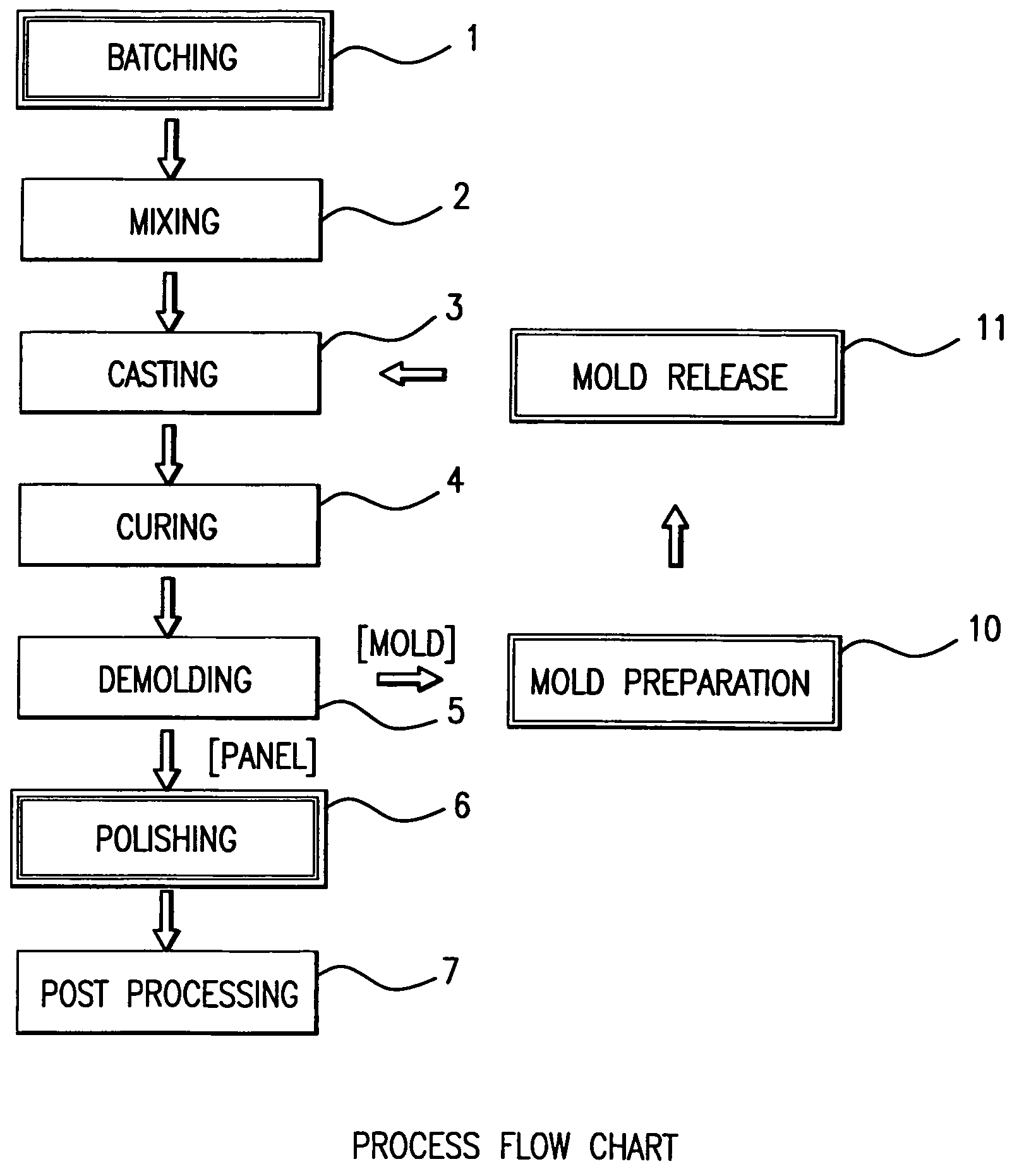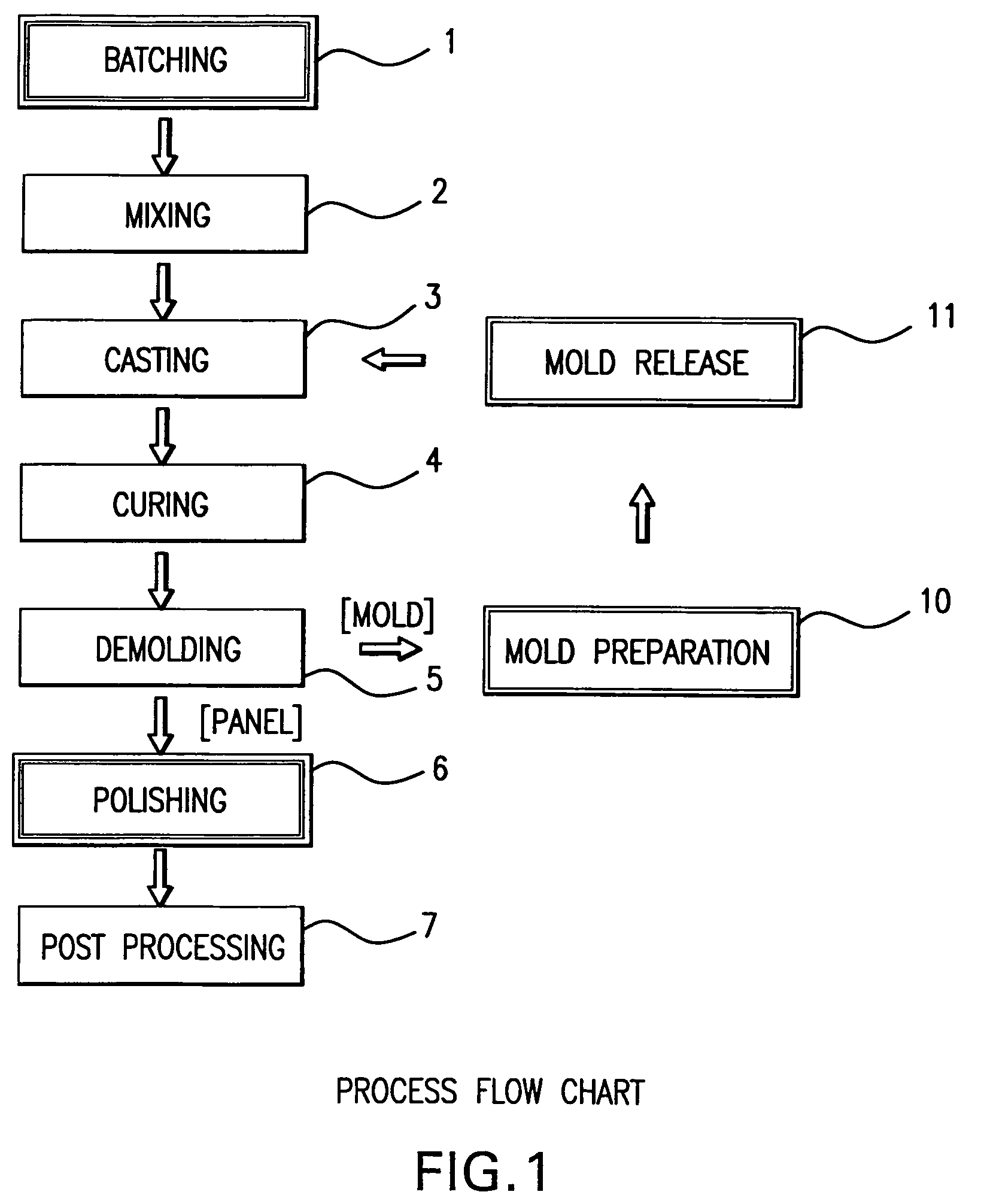Method for producing materials from recycled glass and cement compositions
a technology of compositions and recycled glass, applied in the direction of climate sustainability, solid waste management, feeding arrangments, etc., can solve the problems of difficult to achieve the use of building materials comprised of recycled glass and cement, rendering it useless as a building material, etc., and achieve the effect of active reduction of waste stream
- Summary
- Abstract
- Description
- Claims
- Application Information
AI Technical Summary
Benefits of technology
Problems solved by technology
Method used
Image
Examples
example 1
[0100]A material made in accordance with the invention process was produced. The mold used was in the form of a flat panel having the dimensions 96″×48″ and was approximately 1 inch in thickness. The composition used is detailed in Table I below and included no pigment. This panel contains recycled soda lime glass (clear glass) and particle sizes range from No. 2 mesh down to No. 100 mesh. This formulation compared with Example 2 and Example 9 is used to demonstrate the ability to change appearance through particle size distribution.
[0101]
TABLE IPanel Thickness (inch) ∥1Calculated Wt. (Kg)Portland Type I36.02Metakaolin3.94Water16.11Dispersant (Msterbuilder Glenium 3200)0.37Pigment0.00Viscosity Modifying Agent0.024(Masterbuilders VMA 358)Glass125.59Total182.05
example 2
[0102]A material made in accordance with the invention process was produced. The mold used was in the form of a flat panel having the dimensions 96″×48″ and was approximately 0.5 inch in thickness. Four panels were produced from the composition detailed in Table II below. The recycled glass used was a combination of clear type and plate type soda lime glass and particle sizes range from No. 8 mesh down to No 100 mesh. This formulation compared with Example 1 and Example 9 is used to demonstrate the ability to change appearance through particle size distribution. The composition used included no pigment. This example along with Example 3 and others further demonstrates the ability to change the thickness of the panels.
[0103]
TABLE IIPanel Thickness (inch) ∥0.5Calculated Wt. (Kg)Portland Cement Type III White20.34Metakaolin2.23Water9.11Dispersant (Masterbuilders Glenium 3200)0.17Viscosity Modifying Agent0.0123(Masterbuilders VMA 358)Glass70.95Total102.85
example 3
[0104]A material made in accordance with the invention process was produced. The mold used was in the form of a flat panel having the dimensions 96″×48″ and was approximately 2 inches in thickness. The composition used is detailed in Table III below and included a green pigment and contains recycled clear type soda-lime glass with particle sizes ranging from No. 4 mesh down to No. 100 mesh. This composition demonstrates the use of pigment to modify appearance.
[0105]
TABLE IIIPanel Thickness: ∥(inch)2Calculated Wt. (Kg)Portland Cement Type III72.49Metakaolin7.94Water36.20Dispersant (Sikament1.122000)Green Pigment (Bayer0.22GNFC)Viscosity Modifying Agent0.05(Sika VMA)Glass252.82Total370.84
PUM
| Property | Measurement | Unit |
|---|---|---|
| particle size | aaaaa | aaaaa |
| vibration frequency | aaaaa | aaaaa |
| RH | aaaaa | aaaaa |
Abstract
Description
Claims
Application Information
 Login to View More
Login to View More - R&D
- Intellectual Property
- Life Sciences
- Materials
- Tech Scout
- Unparalleled Data Quality
- Higher Quality Content
- 60% Fewer Hallucinations
Browse by: Latest US Patents, China's latest patents, Technical Efficacy Thesaurus, Application Domain, Technology Topic, Popular Technical Reports.
© 2025 PatSnap. All rights reserved.Legal|Privacy policy|Modern Slavery Act Transparency Statement|Sitemap|About US| Contact US: help@patsnap.com


